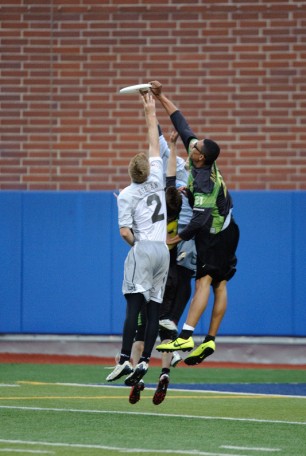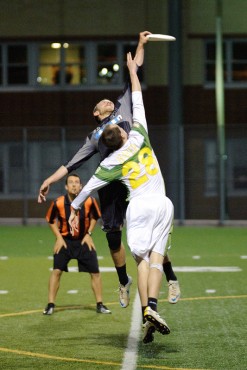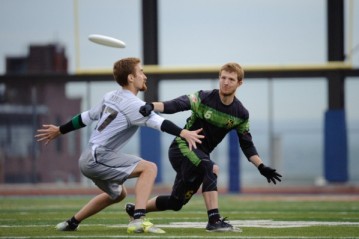On Sunday the DC Current will host the New York Rumble. The winner will qualify for the playoffs and the loser will be done for the season. While both teams have games the day before, those games have no playoff implications, so both will probably rest their top players. Sunday is the game that matters. The teams have already played twice this season, and they have split the series so far.
May 18, at New York. Rumble 17, Current 14.
The Current and Rumble entered this game 1-3, and with relatively full rosters. The game demonstrated the kind of star power that both teams rely on. Alan Kolick and Sean Keegan drove the DC offense, with Keegan throwing three assists and catching three goals, while Kolick caught one goal and threw five. New York had their own star power of course, with Chris Mazur having a spectacular game, catching four goals and throwing three assists. Dan Hejimen and Ben Faust also were major contributors, both catching two goals and Hejimen throwing three assists. Those three players have been key for New York all season. The big time playmakers played well in this game for both teams. Though important, there was more to the game than that. There were three main factors in the Rumble victory:
1. New York O-Line Hucks
Naturally the New York O-Line is stacked. Mazur, Hejimen, and Faust all play on the O-Line, and are supported by players like Kevin Terry and Jody Avirgan. Most of the hucks (throws for 40 or more yards) from the Rumble O-Line come from Mazur as a handler, or Hejimen as a cutter. On May 18 they were 7 for 11. For a team that likes to air it out, 7 for 11 is a great result on such long looks. While the Current O-Line wasn’t unsuccessful on hucks, they were 4 for 7, they didn’t take nearly as many or convert at as high a percentage. DC doesn’t play the hucking game as much as New York does, so it’s not like they need to complete more hucks than New York to win. But they do need to ensure that New York doesn’t complete such a high percentage. New York was 64% on its hucks. The Current O-Line only converted 13 of its 31 possessions into goals, good for only 42%. If the Rumbles O-Line hucks are 20% more efficient than DC’s offense, it’s very unlikely the Current win.
2. The Current D-Line
The Current D-Line is anchored by Markham Shofner. Though Shofner plays some on the O-Line as well, he is the go to handler on the D-Line. In addition to strong defenders like Dan Kantor, O-Line players Sean Keegan and Jeff Wodatch join him on the D-Line on occasion, more often in the second half. In this game the Current D-Line was very inefficient.

Joe Anderson helped the New York D-Line execute better than their DC counterparts (Photo by Sean Carpenter-Ultiphotos.com)
In their eight possessions, only once did they convert for a goal. That’s 12.5%, a truly terrible conversion rate. D-Line’s typically have lower conversion rates than their O-Line counterparts, but no matter how you slice it, 1 for 8 is just bad. The Current D-Line was 0 for 4 on hucks as well, not surprising given their low efficiency. This is what happens to the Current D-Line when Shofner has a bad game, as he did that day. The DC coaching staff distrusted their D-Line so much that the last two defensive points the Current played, they sent the entire O-Line on the field instead. Meanwhile, the Rumble D-Line was 4 for 11. Not great by any stretch, but far better than 1 for 8. And New York did one thing far better on defense than the Current did, which brings us to the third factor.
3. Timeouts
In the MLU each team has two timeouts per half, and after calling a timeout you can sub in a whole new line, and the stall count resets. This changes the nature of smart timeout calling. The best time to use your timeouts in the MLU is after the D-Line has forced a turn. This way a team can sub in its entire offensive line to do what it does best, after the D-Line has accomplished its goal of forcing a turnover. The Current only used one timeout under those circumstances, while the Rumble used three. Using only one of four timeouts at an optimal time cost the team. Though there can be other good times to use a timeout, after a point to refocus and stop a run is one such example, at such a high level teams should be using their timeouts more efficiently. Especially in a game where their D-Line was struggling so much, the Current should have put their timeouts to better use. The DC O-Line did score after subbing in for their one opportunity, while the Rumble converted two out of three.
June 8, at New York, Current 19, Rumble 17 (OT)
In what was one of the most exciting games of the MLU season, the Current kept their playoff hopes alive by winning in New York. The Current played better than they did in the first meeting between the teams, and once again there are three factors to consider when looking back at this game:
1. Injuries
It’s more difficult to draw meaning from a game that so many important players missed. For New York, Ben Faust was out, Dan Hejimen was playing injured, and Chris Mazur went down in the second quarter and didn’t return. For the Current Alan Kolick was playing hurt as well, and had to sit out the fourth quarter and overtime. With so many players out the Rumble weren’t supposed to hang with the Current, yet they did. At the same time, the Current aren’t exactly used to operating without Alan Kolick on their O-Line, he leads the MLU in assists and throws completed.
2. The Current D-Line
In their first game the Current D-Line converted one out of eight opportunities. In this game they converted six out of 11. That is where DC won this game. Their O-Line was still ordinary, in fact 13 for 31, the same as the first game. But their D-Line was something else. There were a few factors in their D-Line success, but none bigger than Markham Shofner. Shofner had a much better game, with two goals and three assists for DC. He also played some on the Current O-Line, especially in the second half, but his play on the D-Line, which completed 2 out of 3 hucks, really made the difference in this game. Of course another difference in the D-Line this game was that Jeff Wodatch and Sean Keegan were playing more defensive points than ever, giving the Current defense more options on offense after forcing a turnover.
3. The Mazur-less New York O-Line
After Mazur got injured in the second half one might have expected the New York offense to change. Playing without its MVP candidate, it seemed like New York would probably look to work the disc under. Interestingly, that’s not how it played out. The Rumble O-Line kept hucking at the same pace, eventually finishing a respectable 5 for 10 on hucks. Not only did the Rumble continue to huck, they also continued to center their offense on one handler. For a few points it was Webster McBride, but it was usually Kevin Terry. Terry ended up with more touches than anyone else this game, and ended the game with five assists. He did have a costly throwaway the first point of overtime though, which unfortunately set the tone for the rest of the period for New York. If Mazur gets re-injured during the game Sunday, this stretch will be an important experience for the Rumble to fall back on.
June 23, at DC, Current vs. Rumble
What to Watch For
1. Playing Injured
Alan Kolick, and Chris Mazur will have had two weeks to recover from their injuries. Though they could potentially play Saturday, I can’t believe that either team would put their playoff hopes in such jeopardy for a game that has no meaning. The question is, who will have healed in time for the game and who will be playing hurt?

The status of Chris Mazur's injury is a big question going into this weekends game (Photo by Brian Canniff-Ultiphotos.com)
Mazur’s injury looked the worse, and though he will undoubtedly play, if he’s playing hurt he probably won’t get open downfield nearly as often. Mazurs ability to get open downfield is even more key given that Dan Hejimen has a knee injury, and won’t be playing Sunday. Since Mazur and Hejimen are the two players most able to throw and receive deep looks on the Rumble roster, the status of Mazur’s injury is an even bigger question mark for the Rumble. If Kolick is slowed down by his hamstring it could make for fewer Alan Kolick moments, which might make the Current offense more reliant on Sean Keegan. When Keegan is on, his quick release hucks are pinpoint and flatter than most in the MLU, making them harder to defend. But they’re not always on, and if Keegan has to handle more that means he won’t be able to get open deep as often, another strength in his game.
2. Individual Matchups
Much was made of the potential matchup of Dan Kantor guarding Chris Mazur in the second game between these two teams. With Chris Mazur missing more than half the game, that matchup never came to fruition. This time, both Kantor and Mazur will have the opportunity to show why they’re so valuable. Mazur has been one of the top handlers (if not the top handler) in the league, but guarding top handlers isn’t unfamiliar territory for Kantor. He had the unenviable task of guarding Brandon Malecek in the Current’s latest tilt with Boston, and produced one of the highlights of the season so far. On the other side of the disc, it’s understood that no one can stop Alan Kolick. Slowing him down or making him work harder could make a big difference for the Rumble though. Joe Anderson has been the player the Rumble have primarily relied upon to guard Kolick so far this season. Anderson guarded him for the first three quarters in the first game between the two teams, and whenever Kolick was in for the second game. New York was probably hoping that Anderson’s taller frame and strong mark would cut down on the Kolick break throws, but Anderson wasn’t really able to slow him down or cut off those looks. It may be that no New York player is capable of it, but one player you might see guard Kolick more this game is Jonathan Cox. Cox is second in the MLU in D’s (New York player Rob Baker leads the league) and matched up with Kolick in the fourth quarter of their first game. Cox played strong defense, helping spark a run by the Rumble D-Line. DC only started to score once they put Kolick on the DC D-Line. The Rumble also might want to consider a defensive rotation against Kolick, to try to make sure he doesn’t get comfortable going against the same opponent all game.

How much playing time will Jeff Wodatch get on the Current D-Line on Sunday? (Photo by Sean Carpenter-Ultiphotos.com)
3. Stacking the D-Line
The Current have frequently stacked the D-Line with O-Line players, usually later in the game. On Sunday I’d expect to see Keegan and Wodatch on the D-Line even earlier than usual. The Rumble haven’t stacked their D-Line with O-Line players against the Current this season, but they have in other games, particularly in big games against the Spinners. Of course stacking the D-Line with O-Line players comes with consequences; poorer defense (not always but sometimes) and fatigue issues later in the game (always). If Keegan and Wodatch play every offensive point and over half the defensive points, they are going to be very tired by the end of the game. The same goes for the Rumble, who saw some effects of switching players back and forth in their second game against the Current, when Joe Anderson was playing on both lines and cramped up in the fourth quarter. Both teams are going to have to strike a balance, but with the season on the line you can bet they won’t err on the side of caution.
Feature photo by Brian Canniff-Ultiphotos.com









Comments Policy: At Skyd, we value all legitimate contributions to the discussion of ultimate. However, please ensure your input is respectful. Hateful, slanderous, or disrespectful comments will be deleted. For grammatical, factual, and typographic errors, instead of leaving a comment, please e-mail our editors directly at editors [at] skydmagazine.com.